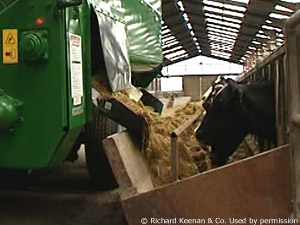Managing Costs and Protecting Financial Health in the Dairy Herd: Where to make savings?
12 May 2020The biggest expense on the dairy farm is by far feed, followed by labour, depreciation and supplies (in no particular order as this may vary from farm to farm).
Many farms are running on the minimal amount of labour they can get away with and it is very difficult to reduce depreciation costs. However, you can influence depreciation by considering whether you really need all the machinery present on the farm, or can you get away without purchasing more? Consider how much a purchase will impact on cost per cow and what the economic return will be.
While it may be tempting to look at cutting a number of costs, beware of cutting costs that directly impact on “cow care”, which can potentially affect cow performance. This includes feed, bedding, veterinary costs and vaccines, reproductive aids and hoof care. When milk price is poor it is often feed and veterinary costs that get cut because they can. Profitable milk production begins with healthy, balanced diets and healthy cows. It is important not to cut anything that will impact on pregnancy rate and getting cows back in calf. Doing away with routine vet visits could be false economy if fertility issues are not picked up and acted upon quickly. Maintaining fertility will help the dairy to remain profitable in the long-term. For all-year-round calving herds, generally lower days in milk means higher milk production and lower feed costs per litre.
Cutting concentrates and lowering milk output will more often than not be a false economy. Professor Mike Hutjens from the University of Illinois has 5 golden rules for feeding when milk prices are low:
- Never give up milk. Reducing milk output by cutting feed costs is rarely profitable (although might be a route you have to consider if your milk buyer has requested lower volumes). If you do cut concentrates, target mid to late lactation cows and be wary about reducing concentrates too much for early lactation cows which are not yet in calf and do not reduce concentrate to less than 80% of current level.
- Maximise your milk cheque through meeting buyer specifications on milk composition and hygiene quality.
- When making feed decisions, keep in mind long-term consequences. He suggests not cutting additives such as yeasts and mycotoxin binders as chances are the benefit outweighs their cost. Also, beware that removing chelated trace minerals may increase mastitis risk, lower fertility and immunity. Assess feed additive costs and benefits carefully and their long-term impact on health and performance. Again, protect the fertility of high yielding cows and save on additive costs for mid to late lactation cows if you can split the herd for feeding separate groups.
- Monitor cow response closely to any feed changes. For example, if milk urea creeps up, can you get away with feeding less protein which is more expensive than energy in the ration? Are there changes in dry matter intake or milk output or milk composition by more than 0.1% point? If so, what are the economic consequences of this?
- Dry matter intake is key. Any change that reduces intake can lead to slower rumen fermentation, reduced energy intake and microbial protein synthesis. This can lead to lower milk yield, body condition loss and affect fertility. Fresh cows will suffer the most.
Consider grazing the lower yielders if grazing infrastructure is in place and cows can be grazed close to the trading. Cows giving under 30 litres should be able to have their requirements met with grass and cake, with good grazing management.
If cutting costs reduces output, work out what that means to the bottom line. Whilst some veterinary costs such as vaccines are tempting to cut when milk prices are low, prevention is usually cheaper than treating a disease outbreak, so evaluate vaccine use with your vet. When it comes to herd health, lameness is the biggest cost on dairy farms, followed closely by fertility and mastitis.
Other costs that are less likely to impact on cow performance in the short-term should be closely looked at to see where savings can be made. This includes things like equipment which does not affect the cow, expensive semen and genomic testing.
Lorna MacPherson, SAC Consulting, for the Farm Advisory Service
Related articles
Sign up to the FAS newsletter
Receive updates on news, events and publications from Scotland’s Farm Advisory Service

